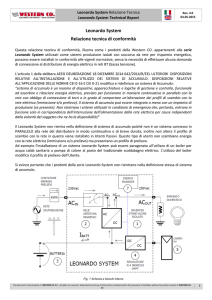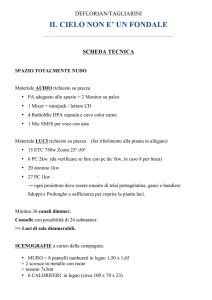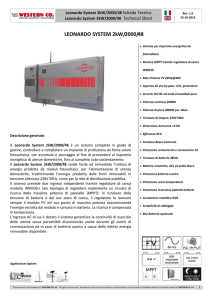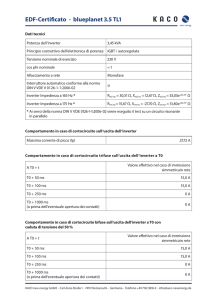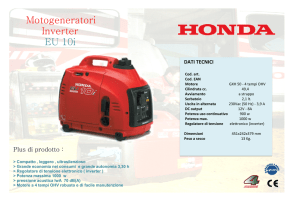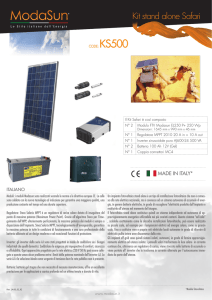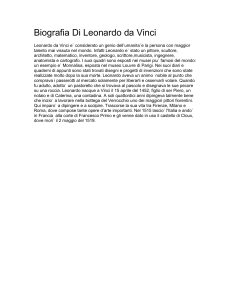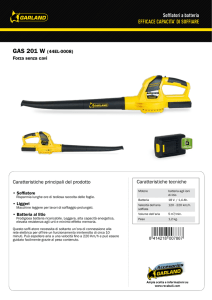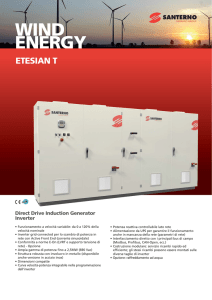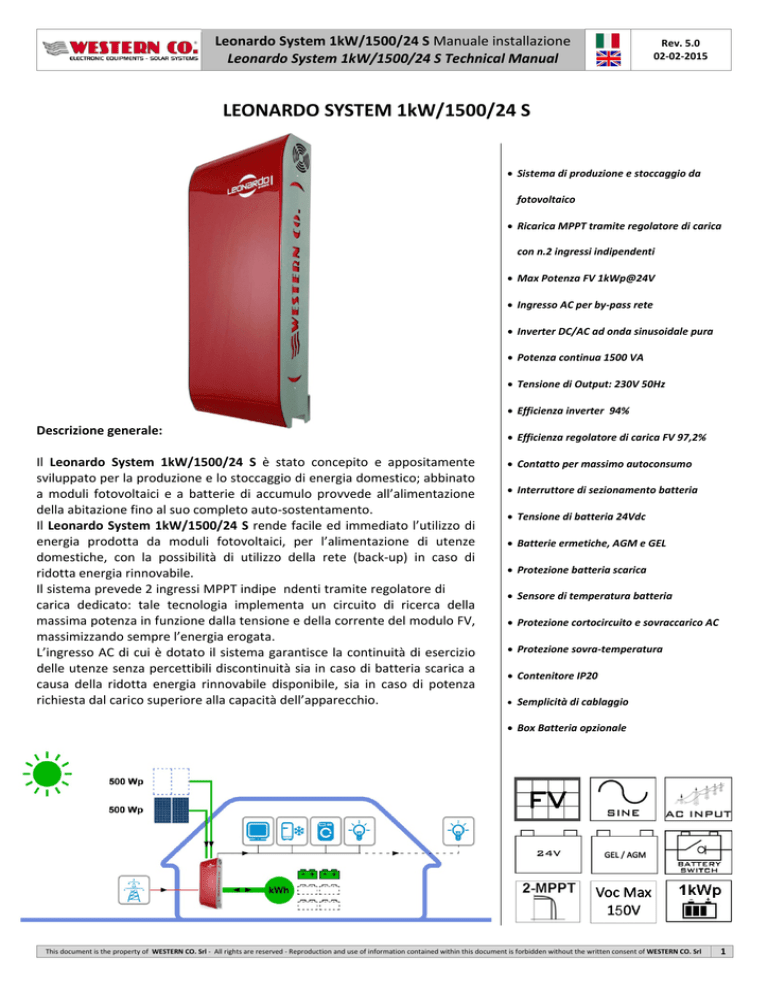
Leonardo System 1kW/1500/24 S Manuale installazione Leonardo System 1kW/1500/24 S Technical Manual
Rev. 5.0 02‐02‐2015
LEONARDO SYSTEM 1kW/1500/24 S Descrizione generale: Il Leonardo System 1kW/1500/24 S è stato concepito e appositamente sviluppato per la produzione e lo stoccaggio di energia domestico; abbinato a moduli fotovoltaici e a batterie di accumulo provvede all’alimentazione della abitazione fino al suo completo auto‐sostentamento. Il Leonardo System 1kW/1500/24 S rende facile ed immediato l’utilizzo di energia prodotta da moduli fotovoltaici, per l’alimentazione di utenze domestiche, con la possibilità di utilizzo della rete (back‐up) in caso di ridotta energia rinnovabile. Il sistema prevede 2 ingressi MPPT indipe ndenti tramite regolatore di carica dedicato: tale tecnologia implementa un circuito di ricerca della massima potenza in funzione dalla tensione e della corrente del modulo FV, massimizzando sempre l’energia erogata. L’ingresso AC di cui è dotato il sistema garantisce la continuità di esercizio delle utenze senza percettibili discontinuità sia in caso di batteria scarica a causa della ridotta energia rinnovabile disponibile, sia in caso di potenza richiesta dal carico superiore alla capacità dell’apparecchio. Sistema di produzione e stoccaggio da fotovoltaico Ricarica MPPT tramite regolatore di carica con n.2 ingressi indipendenti Max Potenza FV 1kWp@24V Ingresso AC per by‐pass rete Inverter DC/AC ad onda sinusoidale pura Potenza continua 1500 VA Tensione di Output: 230V 50Hz Efficienza inverter 94% Efficienza regolatore di carica FV 97,2% Contatto per massimo autoconsumo Interruttore di sezionamento batteria Tensione di batteria 24Vdc Batterie ermetiche, AGM e GEL Protezione batteria scarica Sensore di temperatura batteria Protezione cortocircuito e sovraccarico AC Protezione sovra‐temperatura Contenitore IP20 Semplicità di cablaggio Box Batteria opzionale This document is the property of WESTERN CO. Srl ‐ All rights are reserved ‐ Reproduction and use of information contained within this document is forbidden without the written consent of WESTERN CO. Srl 1
Leonardo System 1kW/1500/24 S Manuale installazione Leonardo System 1kW/1500/24 S Technical Manual
Rev. 5.0 02‐02‐2015
FUNZIONAMENTO DEL LEONARDO SYSTEM 1kW/1500/24 S
1‐
2‐
3‐
4‐
5‐
6‐
7‐
Il Leonardo System 1kW/1500/24 S è progettato per ottenere un risparmio energetico diretto tramite l’utilizzo di energia fotovoltaica ed altre fonti rinnovabili; L'impianto fotovoltaico viene gestito tramite il regolatore di carica con 2 ingressi MPPT indipendenti; L’inverter interno garantisce un risparmio di energia elettrica con produzione diretta dalle fonti rinnovabili o da energia immagazzinata in batteria; Il Leonardo System 1kW/1500/24 S garantisce una continuità di servizio, qualora si verifichi un sovraccarico o energia disponibile da fonte rinnovabile insufficiente, commutando sulla rete AC in ingresso AC‐IN; Un contatto pulito per massimo autoconsumo permette di attivare carichi utilizzatori (scaldabagno, pompa di calore, etc...) aumentando la propria quota di energia auto‐consumata; Sulla linea delle utenze, AC‐OUT, l’energia sarà erogata con la seguente priorità degli ingressi: autoconsumo diretto dai moduli FV autoconsumo da accumulo in batteria contatto per massimo autoconsumo soccorso da rete AC‐IN; L’energia rinnovabile è sempre utilizzata per l’alimentazione diretta del carico, solo l'eccesso viene utilizzato per la ricarica delle batterie ed il successivo utilizzo; Fig.1 Pannello frontale POTENZA CONTRATTUALMENTE IMPEGNATA > 3,0kW Fig.2 Schema di principio This document is the property of WESTERN CO. Srl ‐ All rights are reserved ‐ Reproduction and use of information contained within this document is forbidden without the written consent of WESTERN CO. Srl 2
Leonardo System 1kW/1500/24 S Manuale installazione Leonardo System 1kW/1500/24 S Technical Manual
Rev. 5.0 02‐02‐2015
8‐ Nel caso di batteria scarica, il carico viene commutato sulla rete AC‐IN e l'accumulo in batteria rimane libero per la successiva disponibilità di energia dai moduli FV. 9‐ In caso di black‐out, tutta l’energia immagazzinata nelle batterie viene utilizzata per far fronte alla condizione di emergenza fino allo spegnimento dell’apparecchio che avviene ad una capacità residua del 10‐20%; 10‐ La visualizzazione dello stato di carica è disponibile sugli indicatori luminosi, come anche la potenza di assorbimento del carico utilizzatore e le condizioni di funzionamento: Inverter Mode e By‐Pass Mode; 11‐ L’ingresso AC‐IN prevede il collegamento alla rete di pubblica distribuzione sempre in modalità di prelievo, infatti il Leonardo System NON immette mai energia in rete e NON è mai in parallelo con la rete; 12‐ in caso di presenza di ulteriori impianti di energia rinnovabile (fotovoltaico, eolico, idroelettrico... ), questi possono essere esternamente collegati direttamente sulla batteria con un regolatore di carica dedicato; PROTEZIONI ESTERNE Protezioni lato Corrente Alternata Il Leonardo System 1kW/1500/24 S è dotato di una linea di uscita in corrente alternata AC‐OUT ed una linea di ingresso in corrente alternata AC‐IN. Essendo l'apparecchio dotato di collegamento a terra del conduttore NEUTRO ‐ sistema TT, la linea di uscita in corrente alternata AC‐OUT può essere protetta con un interruttore magnetotermico‐differenziale di tipo AC, con corrente nominale In=16A e corrente differenziale Id=0,03A ( questo interruttore di solito è già presente nel quadro di distribuzione dell'abitazione come protezione dai contatti indiretti, con corrente differenziale 30mA). La linea di ingresso in corrente alternata AC‐IN può essere protetta con un interruttore magnetotermico‐
differenziale di tipo AC, con corrente nominale In=16A e corrente differenziale Id=0,3A, questo interruttore può essere inserito in un quadro generale aggiuntivo o, se possibile, nel quadro di distribuzione esistente nell'abitazione. Protezioni lato Corrente Continua Il collegamento del banco batterie è effettuato tramite fusibile di protezione sul polo positivo, inoltre l'interruttore di sezionamento del polo positivo provvede all'attivazione dell'inverter in completa sicurezza. ATTENZIONE: gli accessori di montaggio del fusibile batteria sono pensati per batterie che hanno morsetti di fissaggio con bulloni M8, nel caso di diverso diametro del bullone di fissaggio non sarà possibile utilizzare gli accessori a corredo. Fig.3 Fusibile di Protezione Dado plastico Occhiello d.10mm Fusibile 300A Dado M8 rondellato Occhiello d.8mm cavo INVERTER cavo PARALLELO BATTERIA Grano M8 x 60mm This document is the property of WESTERN CO. Srl ‐ All rights are reserved ‐ Reproduction and use of information contained within this document is forbidden without the written consent of WESTERN CO. Srl 3
Leonardo System 1kW/1500/24 S Manuale installazione Leonardo System 1kW/1500/24 S Technical Manual
Rev. 5.0 02‐02‐2015
INTERRUTTORE DI SEZIONAMENTO BATTERIA L'attivazione dell'interruttore di sezionamento del polo positivo di batteria realizza l'accensione dell'inverter in completa sicurezza. ATTENZIONE: nella sequenza di ACCENSIONE dell'apparecchio l'interruttore di sezionamento batteria deve essere attivato ON per PRIMO, rispetto ai collegamenti FV e corrente alternata AC‐IN e AC‐OUT. Nella sequenza di SPEGNIMENTO dell'apparecchio l'interruttore di sezionamento batteria deve essere disattivato OFF per ULTIMO, rispetto ai collegamenti FV e corrente alternata AC‐IN e AC‐OUT. Fig.4 Interruttore di sezionamento Batteria LOGICA DI CONTROLLO Sezione Inverter Fig. 5 Logica di controllo Inverter
t1 all’accensione l’inverter si porta in modalità Inverter e alimenta i carichi in uscita; t2 con la disponibilità di potenza fotovoltaica, si ha autoconsumo diretto ed accumulo in batteria, se la potenza fotovoltaica è maggiore della potenza richiesta dai carichi, la tensione di batteria sale sino ad una tensione superiore ai 27,0V; t3 se la potenza fotovoltaica risulta insufficiente a sostenere la richiesta del carico in uscita, tale differenza viene compensata dall'accumulo in batteria ed il carica batterie solare eroga la potenza disponibile direttamente ai carichi utilizzatori; t4 se l’energia consumata dal carico è superiore a quella disponibile da fonte rinnovabile, la batteria viene scaricata fino alla tensione di commutazione 23V dell'utenza sulla linea di ingresso in modalità Bypass; t5 la ricarica dal fotovoltaico riporta la tensione di batteria alla tensione di 27,0V, per almeno 10 minuti, affinché il sistema commuti nuovamente in modalità Inverter; t6 in caso di Black‐Out, viene forzata la modalità Inverter, al fine di utilizzare tutta l’energia disponibile in batteria, fino alla capacità residua del 10% (tensione di batteria di circa 22V), fino al definitivo spegnimento che viene segnalato dal display; (vedi tabella n.4) t7 il ripristino del funzionamento viene effettuato, quando la ricarica dal fotovoltaico, riporta la tensione di batteria ad una tensione superiore ai 23V; This document is the property of WESTERN CO. Srl ‐ All rights are reserved ‐ Reproduction and use of information contained within this document is forbidden without the written consent of WESTERN CO. Srl 4
Leonardo System 1kW/1500/24 S Manuale installazione Leonardo System 1kW/1500/24 S Technical Manual
Rev. 5.0 02‐02‐2015
Sezione Regolatori di Carica Fotovoltaica Il Leonardo System 1kW/1500/24 S è dotato di regolatore di carica FV con 2 ingressi MPPT indipendenti: è un regolatore di carica da moduli fotovoltaici per batterie elettrochimiche al piombo di tipo ermetico (SEAL). Per il corretto riconoscimento della tensione di batteria eseguito all’accensione, di conseguenza imposta i parametri di ricarica appropriati come descritto in tab. 1. Tensione di batteria misurata all’avvio 20.0V < Vbatt < 32.0V Batteria a 24V Tab. 1 Rilevamento Tensione di Sistema
Scelta del modulo fotovoltaico Nella scelta della configurazione della stringa di moduli da impiegare nel sistema è necessario attenersi strettamente a quanto indicato nella seguente tabella. Grazie alla presenza del regolatore di carica con circuito di ricarica con MPPT, è possibile collegare i moduli a due ingressi indipendenti garantendo così lo sfruttamento ottimale di tutta la potenza. Caratteristiche moduli PV Tensione nominale batteria Batteria a 24V di tipo ermetico, tensione di carica in fase di tensione costante (ABSORPTION) Vch=28,8V alla temperatura di 25°C Moduli con 60 celle Si mono‐cristallino / poli‐cristallino per una potenza tipica di 230 ‐ 270Wp Collegare 2 moduli in serie per ogni ingresso FV, la potenza per ogni singolo ingresso richiede un minimo di 450 W fino a un massimo di 550 W. Corrente di corto circuito massima: 13A per ogni ingresso. Tensione a circuito aperto massima: 150V per ogni ingresso. Tab. 2 Scelta del Modulo Fotovoltaico
TAbs.
Vch
Vfloat
ABSORPTION
FLOAT
BULK
NOTTE
NOTTE
Fig.6 Curva di carica
I livelli di tensione che il regolatore impone alla batteria Vch , Vfloat sono sempre riferiti alla temperatura nominale di 25°C. Al variare della temperatura anche le tensioni imposte dal regolatore variano, secondo quanto consigliato dai costruttori di batterie; diminuisce di ‐48mV/°C per ogni aumento di un grado di temperatura. I parametri di carica riportati in Fig.6, con valore di fabbrica per batterie ermetiche SEAL e tensione nominale di 24V, pari a Vch=28,8V e Vfloat=27,6V. This document is the property of WESTERN CO. Srl ‐ All rights are reserved ‐ Reproduction and use of information contained within this document is forbidden without the written consent of WESTERN CO. Srl 5
Leonardo System 1kW/1500/24 S Manuale installazione Leonardo System 1kW/1500/24 S Technical Manual
Rev. 5.0 02‐02‐2015
SEGNALAZIONI ESTERNE Sul lato laterale del Leonardo System 1kW/1500/24 S sono presenti le segnalazioni di funzionamento dell’inverter: Inverter Mode e By‐pass Mode, lo stato di carica della batteria, la potenza assorbita dal carico, lo stato del carica da fotovoltaico e la presenza della rete AC in ingresso. Fig.7 Segnalazione Inverter Mode
Nel caso in Fig. 7 è possibile notare lo stato di funzionamento dell’inverter in modalità Inverter Mode: il carico viene alimentato dalle fonti rinnovabili, la batteria presenta uno stato di carica con almeno il 75% di carica residua, il carico assorbe una potenza compresa tra 200W e 1200W, il carica batteria da fotovoltaico è attivo, è presente la rete di ingresso AC. Nel caso di mancanza di fonte rinnovabile la batteria raggiunge lo stato di carica residua del 40%, quindi si passa alla modalità di funzionamento By‐pass Mode: Fig.8 Segnalazione Bypass Mode
Nel caso in Fig. 8 infatti è possibile notare lo stato di funzionamento dell’inverter in modalità Bypass Mode: il carico viene alimentato dall’ingresso AC esterno, la batteria presenta uno stato di carica con almeno il 40% di carica residua, il carico assorbe una potenza compresa tra 1200W e 2200W, il carica batteria da fotovoltaico è attivo ed è presente la rete di ingresso AC. Protezione da sovraccarico Quando si verifica un sovraccarico di potenza sul carico d’uscita (se la potenza supera il limite di 1300 W per 1 secondo) l’inverter commuta sulla rete AC input, visualizzando lo stato di By‐pass Mode. Una volta che la potenza rientra nel limite di 1200 W per 3 minuti l’inverter commuta nella modalità Inverter Mode. ATTENZIONE: per effetto della protezione da sovraccarico e della taglia di inverter Leonardo System 1kW/1500/24 S, il contratto di fornitura di energia elettrica deve prevedere una potenza contrattualmente impegnata di almeno 3kW, che identifica una potenza disponibile di 3,3kW. This document is the property of WESTERN CO. Srl ‐ All rights are reserved ‐ Reproduction and use of information contained within this document is forbidden without the written consent of WESTERN CO. Srl 6
Leonardo System 1kW/1500/24 S Manuale installazione Leonardo System 1kW/1500/24 S Technical Manual
Rev. 5.0 02‐02‐2015
Tabella Stato di carica e potenza di uscita Stato di carica SOC livello 4, l'energia effettivamente stoccata in batteria si trova in un intervallo compreso tra 75% ‐ 100% della propria capacità nominale. (Tensione maggiore di 27,2V) Potenza di uscita LOAD livello 4, la potenza elettrica delle utenze in uscita è superiore al livello di 4000W. Stato di carica SOC livello 3, l'energia effettivamente stoccata in batteria si trova in un intervallo compreso tra 60% ‐ 75% della propria capacità nominale. (tensione maggiore di 24V) Potenza di uscita LOAD livello 3, la potenza elettrica delle utenze in uscita è compresa in un intervallo di 2200W ‐ 4000W. Stato di carica SOC livello 2, l'energia effettivamente stoccata in batteria si trova in un intervallo compreso tra 40% ‐ 60% della propria capacità nominale. (tensione maggiore di 23V) Potenza di uscita LOAD livello 2, la potenza elettrica delle utenze in uscita è compresa in un intervallo di 1200W ‐ 2200W. Stato di carica SOC livello 1, l'energia effettivamente stoccata in batteria si trova in un intervallo compreso tra 30% ‐ 40% della propria capacità nominale. (tensione maggiore di 21V) Potenza di uscita LOAD livello 1, la potenza elettrica delle utenze in uscita è compresa in un intervallo di 200W ‐ 1200W. Tab. 3 Stato di Carica e Potenza di Uscita
Tabella segnalazione LED STATUS
LED STATUS LED STATUS LED STATUS LED STATUS Led VERDE: normale stato di funzionamento attivo ON. Led ROSSO n.1 lampeggio ogni 10 Secondi: stato di allarme SOVRA‐TEMPERATURA. Led ROSSO n.2 lampeggi ogni 10 Secondi: stato di allarme LOW‐BATTERY. Led ROSSO n.3 lampeggi ogni 10 Secondi: stato di allarme OVER‐LOAD. Tab. 4 Segnalazione LED STATUS
ATTENZIONE: in caso di BLOCCO dell'inverter, nessuna tensione di alimentazione sull'uscita AC‐OUT, causa una delle tre condizioni di anomalia indicate in tab. 2, è necessario un RIAVVIO dell'apparecchio, come da sequenza: Sequenza SPEGNIMENTO: 1. apertura AC‐OUT => 2. apertura AC‐IN => 3. apertura fotovoltaico PV1‐PV2 => 4. apertura BATTERIA Sequenza RIAVVIO: 1. chiusura BATTERIA => 2. chiusura fotovoltaico PV1‐PV2 => 3. chiusura AC‐IN => 4. chiusura AC‐OUT This document is the property of WESTERN CO. Srl ‐ All rights are reserved ‐ Reproduction and use of information contained within this document is forbidden without the written consent of WESTERN CO. Srl 7
Leonardo System 1kW/1500/24 S Manuale installazione Leonardo System 1kW/1500/24 S Technical Manual
SCHEMA DI COLLEGAMENTO INVERTER DC/AC ‐ Potenza continua 1500 VA ‐ Potenza di sovraccarico 1300W ‐ Ingresso AC ‐ Batteria 24Vdc
Rev. 5.0 02‐02‐2015
CAMPO FV ‐ 2 ingressi MPPT indipendenti ‐ Potenza max 1 kWp ‐ Potenza max singolo ingresso 500W ‐ 2 stringhe da 2 moduli FV da 60 celle, es. 250W DATA LOGGER OPZIONALE ‐ Energia prodotta ‐ Energia prelevata ‐ Indice di indipendenza energetica BANCO BATTERIE ‐ Tensione di sistema 24Vdc ‐ Capacità consigliata impianto FV da 500Wp: 100Ah ‐ 2,4kWh ‐ Capacità consigliata impianto FV da 1kWp: 150Ah ‐ 3,6kWh CONTATTO PER MASSIMO AUTO‐CONSUMO ‐ contatto pulito COM‐NC‐NO ‐ 4A @ 230VAC ‐ 1A @ 60VDC ‐ Es. Boiler con PDC Fig. 9 Schema di collegamento
INSTALLAZIONE E CABLAGGIO 1. Installare il Leonardo System 1kW/1500/24 S in un luogo asciutto ed adeguatamente arieggiato, fissato su di una superficie non infiammabile e posizionato in modo da lasciare uno spazio privo di ostacoli di almeno 10cm nell’intorno del dispositivo che ne permette il raffreddamento per convezione forzata dell’aria. 2. Fissare a muro la staffa di supporto (fornita in dotazione) tramite i tasselli e le viti fornite in dotazione; successivamente agganciare l’inverter tramite la piastra ad uncino posta nella parte superiore dell’apparecchio. Infine fissare l’inverter alla parete utilizzando i fori predisposti nella parte inferiore dell’apparecchio. Il tutto come indicato in Fig. 10. This document is the property of WESTERN CO. Srl ‐ All rights are reserved ‐ Reproduction and use of information contained within this document is forbidden without the written consent of WESTERN CO. Srl 8
Leonardo System 1kW/1500/24 S Manuale installazione Leonardo System 1kW/1500/24 S Technical Manual
Rev. 5.0 02‐02‐2015
PIASTRA AD
UNCINO parte
superiore dell’inverter
STAFFA DI
SUPPORTO
PIASTRA parte
inferiore dell’inverter
Fig. 10 Montaggio a parete
3. Collegare nell’ordine: 1. cavo batteria positivo (vedi collegamento nella sezione Protezioni Lato Corrente Continua); 2. cavo batteria negativo; 3. attivare l'interruttore di sezionamento batteria ‐ posizione ON; 4. collegare i moduli fotovoltaici PV1‐PV2 (verificando la polarità di ciascuna coppia di cavi che dovrà essere collegata in ingresso all’inverter); 5. collegare ingresso AC‐IN su connessione AC Input tramite connettori AC plug and play tipo RST; 6. collegare uscita AC‐OUT su connessione AC Output tramite connettori AC plug and play tipo RST; 7. posizionare infine l’apposito cavo al sensore di temperatura delle batterie in prossimità della stessa, al fine di un corretto rilevamento. AC INPUT
Cablaggio tramite connettori
plug and play a 3 poli - 6mm^2
AC OUTPUT
Cablaggio tramite connettori plug
and play a 3 poli - 6mm^2
PV INPUT +
Numero 2 ingressi positivi
Cablaggio plug and play
4-6mm^2
(in fig. controparte maschio)
PV INPUT Numero 2 ingressi negativi
Cablaggio plug and play
4-6mm^2
(in fig. controparte femmina)
Ingresso DC Batteria
Lunghezza cavo 1,5 m
Sezione 25 mmq
CONTATTO MAX AUTO-CONSUMO
Numero 3 Poli del contatto
COM-NERO NC-BIANCO NO-ROSSO
Ingresso sensore di
temperatura
Lunghezza cavo 1,5 m
Fig. 11 Cablaggio Cavi
This document is the property of WESTERN CO. Srl ‐ All rights are reserved ‐ Reproduction and use of information contained within this document is forbidden without the written consent of WESTERN CO. Srl 9
Leonardo System 1kW/1500/24 S Manuale installazione Leonardo System 1kW/1500/24 S Technical Manual
Rev. 5.0 02‐02‐2015
Poiché l’apparecchio viene dotato di cavo per collegamento batteria di lunghezza 1,5m e sezione 25mmq è assolutamente raccomandato installare il banco batteria ad una distanza tale da mantenere il cavo originale per il collegamento. Aumentare la distanza con il banco batterie comporta un aumento della caduta di tensione sul cavo in fase di funzionamento quindi una errata lettura della tensione di batteria. Utilizzare il cavo in dotazione per effettuare il collegamento ai morsetti principali di batteria e nel caso di un banco batteria costituito da più elementi in serie o in parallelo utilizzare un cavo di sezione minima 25mmq per il cablaggio di ciascun elemento in serie o in parallelo. Si raccomanda l’installazione dell’apparecchio su parete solida in posizione verticale, al fine di assicurare un adeguato ricircolo di aria, dovuta alla ventilazione forzata dell’apparecchio. Per tale motivo è inoltre da evitare l’installazione in luoghi ricchi di polvere e sporco. AVVIAMENTO E COLLAUDO DELL’IMPIANTO Appena realizzati i collegamenti come in Fig. 10 è necessario procedere avviamento e collaudo del sistema: 1) verificare l’accensione del Leonardo System 1kW/1500/24 S al termine del collegamento dei cavi sui morsetti della batteria ed attivazione dell'interruttore di sezionamento batteria; 2) verificare la corretta carica di batteria, in caso contrario verificare la corretta installazione del banco batterie; 3) attivare se presente la linea di ingresso AC attraverso le connessioni AC‐IN. 4) verificare l’attivazione della linea di uscita AC‐OUT, se presente un carico l’inverter eroga potenza e lo stato è disponibile dalle indicazioni luminose del carico LOAD. 5) in base alle condizioni di carica della batteria, della presenza della rete in ingresso, si può osservare il corretto funzionamento della logica di controllo dell’inverter, come da (Fig. 3). CARATTERISTICHE MECCANICHE Fig. 12 Caratteristiche meccaniche
This document is the property of WESTERN CO. Srl ‐ All rights are reserved ‐ Reproduction and use of information contained within this document is forbidden without the written consent of WESTERN CO. Srl 10
Leonardo System 1kW/1500/24 S Manuale installazione Leonardo System 1kW/1500/24 S Technical Manual
Rev. 5.0 02‐02‐2015
CARATTERISTICHE ELETTRICHE Potenza di uscita Pout -
Tensione di batteria Vbatt Tensione di uscita Vac Frequenza di uscita INVERTER PV CHARGER ENCLOSURE Leonardo System
4kW / 3000 / 48V Min
Tip
Max
1500VA
3.000W
-
20,0V
24V
33V
-
230V
-
Fac -
Tempo di trasferimento Tsw Inverter <> Bypass Poc Soglia di sovraccarico -
50Hz
±0,1%
10mS
-
Leonardo System
4kW / 5000 / 48V Min Tip
Max
3000VA
6.000W
-
5000VA
10.000W
40,0V
48V
66V
-
230V
-
40,0V
48V
66V
-
230V
-
-
-
-
-
50Hz
±0,1%
10mS
-
-
-
-
-
50Hz
±0,1%
10mS
-
85%
-
-
85%
-
-
85%
-
Efficienza Eff -
94%
-
-
95%
-
-
95%
-
Assorbimento in by‐pass Pbp -
<4W
-
-
<5W
-
-
<6W
-
Autoconsumo in stand‐by Psb -
10W
-
-
16W
-
-
25W
-
Soglia di commutazione Inverter Mode / By‐pass Mode Soglia di commutazione By‐pass Mode/ Inverter Mode Allarme sovra‐
temperatura interna Temperatura di esercizio Tba 22,9V
23,0V
23,1V
45,9V
46,0V
46,1V
45,9V
46,0V
46,1V
Tbs 27,1V
27,2V
27,3V
54,3V
54,4V
54,5V
54,3V
54,4V
54,5V
Tot Tamb 65°C
-10°C
65°C
25°C
60°C
-10°C
65°C
40°C
60°C
-10°C
25°C
60°C
Min Tip
Max
Min
Tip
Max
Min Tip
Max
Tensione di batteria Vbatt ‐ 24,0V
‐
‐
48,0V
‐
‐ 48,0V
‐
Ingressi MPPT Nmpp ‐ 2 ‐
‐
4
‐
‐ 4
‐
Corrente moduli per canale Tensione moduli a circuito aperto Massima potenza per canale Massima potenza complessiva Tensione di ricarica a 25°C (ABSORPTION) Tempo fase di ABSORPTION Tensione di riposo (FLOAT) Efficienza Ipan ‐ ‐ 13,0A
‐
‐
13,0A ‐ ‐
13,0A
Vpan ‐ ‐ 150V
‐
‐
150V ‐ ‐
150V
Pch ‐ 500W
‐
‐
1kW
‐
‐ 1kW
‐
Pmax ‐ ‐ 1 kW
‐
‐
4 kW ‐ ‐
4 kW
VEoC ‐ 28,8V
‐
‐
57,6V
‐
‐ 57,6V
‐
Tabs ‐ 4h
‐
‐
4h
‐
‐ 4h
‐
Vflt ‐ 27,6V
‐
‐
55,2V
‐
‐ 55,2V
‐
Eff ‐ 97,2%
‐
‐
97,2%
‐
‐ 97,2%
‐
‐ ‐96mV/°C
‐
‐
‐96mV/°C
‐
‐ ‐96mV/°C
‐
‐ 12 mA
‐
‐
12 mA
‐
‐ 12 mA
‐
‐10°C
25°C
25°C
Compensazione della VEoC Vtadj funzione della temperatura di batteria (Tbatt) Autoconsumo Iq Leonardo System
1kW / 1500 / 24V Min Tip
Max
Temperatura di esercizio Tamb ‐10°C 25°C
60°C
Potenza dissipata Pdiss 66W
Min Tip
Sezione dei cavi batteria ‐
25mm
‐
‐
Lunghezza cavi batteria ‐ 1,5mt
‐
‐
Grado di protezione IP20
Dimensioni Peso Max
2
Min
14 Kg
‐10°C Max
Min 25mm
‐
‐
35mm
‐
1,5mt
‐
‐ 1,5mt
‐
IP20
Tip
2
IP20
315x750x130 mm
‐ 60°C
66W 395x940x250 mm
‐
‐
25 Kg
60°C
66W
Tip
Max
2
395x940x250 mm
‐
‐ 37 Kg
‐
Tab.5 Caratteristiche elettriche
This document is the property of WESTERN CO. Srl ‐ All rights are reserved ‐ Reproduction and use of information contained within this document is forbidden without the written consent of WESTERN CO. Srl 11
Leonardo System 1kW/1500/24 S Manuale installazione Leonardo System 1kW/1500/24 S Technical Manual
Rev. 5.0 02‐02‐2015
GARANZIA DI LEGGE Western Co srl garantisce la buona qualità e la buona costruzione dei Prodotti obbligandosi, durante il periodo di garanzia di 5 (cinque) anni, a riparare o sostituire a sua sola discrezione, gratuitamente, quelle parti che, per cattiva qualità del materiale o per difetto di lavorazione si dimostrassero difettose. Il prodotto difettoso dovrà essere rispedito alla Western Co srl o a società delegata dalla Western Co srl a fare assistenza sul prodotto, a spese del cliente, assieme ad una copia della fattura di vendita, sia per la riparazione che la sostituzione garantita. I costi di re‐installazione del materiale saranno a carico del cliente. La Western Co srl sosterrà le spese di re spedizione del prodotto riparato o sostituito. La garanzia non copre i Prodotti che, in base a nostra discrezione, risultino difettosi a causa di naturale logoramento, che presentino guasti causati da imperizia o negligenza del cliente, da imperfetta installazione, da manomissioni o interventi diversi dalle istruzioni da noi fornite . La garanzia decade altresì in caso di danni derivanti da: ‐trasporto e/o cattiva conservazione del prodotto. ‐causa di forza maggiore o eventi catastrofici (gelo per temperature inferiori a ‐20°C, incendio, inondazioni, fulmini, atti vandalici, ecc …). Tutte le sopraccitate garanzie sono il solo ed esclusivo accordo che soprassiede ogni altra proposta o accordo verbale o scritto e ogni altra comunicazione fatta tra il produttore e l’acquirente in rispetto a quanto sopra. Per qualsiasi controversia il Foro competente è Ascoli Piceno. SMALTIMENTO DEI RIFIUTI La Western Co in qualità di produttore del dispositivo elettrico descritto nel presente manuale, ed in conformità al D.L 25/07/05 n 151, informa l’acquirente che questo prodotto, una volta dismesso, deve essere consegnato ad un centro di raccolta autorizzato oppure, in caso di acquisto di apparecchiatura equivalente può essere riconsegnato a titolo gratuito al distributore della apparecchiatura nuova. Le sanzioni per chi abusivamente si libera di un rifiuto elettronico saranno applicate dalle singole amministrazioni comunali. WESTERN CO. S.r.l. Via Pasubio 1 63074 San Benedetto del Tronto (AP) tel 0735 751248 fax 0735 751254 e‐mail: [email protected] web: www.western.it This document is the property of WESTERN CO. Srl ‐ All rights are reserved ‐ Reproduction and use of information contained within this document is forbidden without the written consent of WESTERN CO. Srl 12
Leonardo System 1kW/1500/24 S Manuale Tecnico Leonardo System 1kW/1500/24 S Technical Manual
Rev. 5.0 02‐02‐2015
LEONARDO SYSTEM 1kW/1500/24 S General Description: Leonardo System 1kW/1500/24 S is a complete system able to manage, control and integrate a PV system with storage in order to provide energy savings of households for a complete autonomy. Leonardo System 1kW/1500/24 S facilitates and expedites the use of the energy produced by PV modules transforming it from renewable sources into AC power 230V 50Hz, as for the public distribution grid. inputs through charge controllers that The system has 2 independent
implement MPPT. According to the battery voltage and its charge level, the charge controller activates always the PV module at its higher level maximizing energy from PV module that consequently is charged in the battery. Temperature compensates battery charging. The Leonardo System AC input assures operational continuity of the loads without noticeable discontinuities also during the switching events and in case of low battery because of the reduced renewable energy available. PV Energy Saving System MPPT charge controller with two independent inputs 1kWp @24V Maximum PV power By‐pass AC input: grid, power unit DC/AC pure sine wave inverter 1500 VA Continuous power Output voltage: 230V 50Hz 94% inverter efficiency 97,4% PV charge efficiency Maximum self‐consumption contact Battery switch 24Vdc battery voltage AGM and GEL, sealed lead‐acid batteries Low battery protection Battery temperature sensor Short circuit and AC overload protection Over temperature protection IP20 metal box Easy wiring Optional battery box This document is the property of WESTERN CO. Srl ‐ All rights are reserved ‐ Reproduction and use of information contained within this document is forbidden without the written consent of WESTERN CO. Srl 1
Leonardo System 1kW/1500/24 S Manuale Tecnico Leonardo System 1kW/1500/24 S Technical Manual
Rev. 5.0 02‐02‐2015
How does Leonardo System works
1. Leonardo System 1kW/1500/24 S is specifically designed for energy saving from photovoltaics; 2. It operates through Western CO. charge controller with 2 MPPT independent inputs; 3. It assures energy saving through direct self‐consumption or from stored energy in batteries; 4. It assures continuity of supply in case of overcharges or energy available from insufficient renewable source (back up) available on AC‐grid on AC‐IN input; 5. On consumer unit the priority is as follows: renewable sources battery bank AC‐IN input; 6. Renewable energy supplies the load directly when batteries are fully charged; 7. In case of low battery, the load commutes on AC‐IN grid and the internal charge controller AC works to aid the back up of the normal status of charge so to preserve the useful life of batteries; Fig.1 frontal panel
Fig.2 scheme This document is the property of WESTERN CO. Srl ‐ All rights are reserved ‐ Reproduction and use of information contained within this document is forbidden without the written consent of WESTERN CO. Srl 2
Leonardo System 1kW/1500/24 S Manuale Tecnico Leonardo System 1kW/1500/24 S Technical Manual
Rev. 5.0 02‐02‐2015
7‐ In case of insufficient renewable energy and black out, the whole energy stored in batteries face emergency conditions up to the device turning off (SOC around 10‐20%); 8‐ Thanks to LED indications is possible to notice: charge status, power of auxiliary loads, inverter mode and by‐pass mode; 9‐ In case of stand‐alone installations, the back‐up grid extension can be replaced by a generating set on the AC‐IN input connection; 10‐ Other renewable energy sources with dedicated charge controller can be used for charging the battery, with direct connection to the battery. In this situation, Leonardo System will use this additional energy available. EXTERNAL PROTECTIONS AC protections (not included) Leonardo System 1kW/1500/24 S has an AC –OUT output line and an AC –IN input line. In addiction the device has a NEUTRAL conductor of the grounding connection – TT system. The AC‐OUT output line can be protected through a differential magneto thermal breaker (AC type), with rated current In=16A and differential current Id=0,03A. Also the AC‐IN input line can be provided with a differential magneto thermal breaker (AC type), with rated current In=16A and differential current Id=0,03A. (Please note that in general this kind of breaker is already included in residence control panel.) DC protections After assembling and connecting the battery bank is possible to assembly the protection fuse of the battery on the positive pole. Through the connection of the negative pole, the inverter will be activated. NOTE: Assembling accessories of the fuse battery are suitable for batteries with fixing terminals type M8. In case of different diameter, it is not possible to use the accessories supplied. Connection to the negative pole of the inverter might cause flashes. They are normal considering the charge of the inverter input condensers. Pic.3 Fuse protection Plastic nut Ø10 mm eyelet terminal 300A fuse M8 washer nut INVERTER cable By‐pass battery cable Ø8mm eyelet terminal M8 grub screw x 60mm This document is the property of WESTERN CO. Srl ‐ All rights are reserved ‐ Reproduction and use of information contained within this document is forbidden without the written consent of WESTERN CO. Srl 3
Leonardo System 1kW/1500/24 S Manuale Tecnico Leonardo System 1kW/1500/24 S Technical Manual
Rev. 5.0 02‐02‐2015
BATTERY SWITCH The battery switch can be used for Inverter switch in complete safety. WARNING: the SWITCH ON sequence is: 1) battery switch, 2) PV connection, 3) AC‐IN connection 4) AC‐OUT connection. The SWITCH OFF sequence is: 1) AC‐OUT disconnection, 2) AC‐IN disconnection, 3) PV disconnection, 4) battery switch. Pic.4 battery switch CONTROL LOGIC
Inverter Pic. 5 Inverter Control Logic
t1 During the switching on the inverter is in inverter mode and power supply the loads; t2 When batteries are completely charged (battery voltage around 27V) the system switch to Inverter mode and the load is supplied through batteries; t3 When the renewable source is insufficient to fulfil the output need of the load, battery charge decreases its capacity around the 90% . In this case the PV charge controller supplies the available power but the AC charger is switched off because in storage the priority is for renewable energy; t4 When the energy consumption of the load is inferior than the one available from renewable source, battery reach 100% of its capacity (battery voltage 27V), the PV charge controller regulates the end‐
charge voltage; t5 When charge capacity decrease the PV charge controller supplies in a complementary way to the batteries the necessary power to the inverter t6 If the user load do not decrease, the CPU commutes to the load on the input line “Bypass Mode” and the battery charging from the grid is activated so to aid the restoration of the standard status of the battery charge level t7 In the event of blackout, the CPU return in “Inverter Mode”, so to use all the energy storage in the battery, up to the 10% capacity (battery voltage around 11V), until the definitive switching off signalled in the display. (see table n.4) This document is the property of WESTERN CO. Srl ‐ All rights are reserved ‐ Reproduction and use of information contained within this document is forbidden without the written consent of WESTERN CO. Srl 4
Leonardo System 1kW/1500/24 S Manuale Tecnico Leonardo System 1kW/1500/24 S Technical Manual
Rev. 5.0 02‐02‐2015
PV charge controller section Leonardo System version 1kW/1500/24 S has a PV charge controller with 2 MPPT independent inputs. It is a PV charge controller for electrochemical sealed batteries. For the proper acknowledgement of the battery voltage at start‐up, we recommend to set up the recharge parameters as described in tab.1 Battery voltage at start-up
20.0V < Vbatt < 32.0V
24V battery
Tab. 1 Voltage survey
How to choose the PV module The choice of the PV module is closely related to the battery voltage. To configure the string of modules for the system we recommend to follow the instructions listed in the table reported below. Please note that thanks to the 2 MPPT charge controllers is possible to connect the modules to 2 independent inputs so to assure an exploiting to the full of the whole power. Nominal input voltage PV Modules features 24V battery 60 ‐ cell strings of Si mono crystalline / poly crystalline for a 250Wp Connect 2 modules in series. The power for every single input needs minimum 450W up to 550W. Max Isc is 13A for each input. Max Voc is 150V for each input. Tab. 2 PV module choice
TAbs.
Vch
Vfloat
ABSORPTION
FLOAT
BULK
NOTTE
NOTTE
Pic.6 Charge curve
In the charge curve are clearly indicated 3 steps: Bulk ‐ Absorption ‐ Float Please note that: ‐ recharge parameters have to be considered at 25°C ‐ state and behaviour of temperature: 4mV/cell for every grade ‐ charge parameters according to factory default values for SEAL batteries and nominal voltage at 48V that is Vch = 57.6 and Vfloat = 53.6. This document is the property of WESTERN CO. Srl ‐ All rights are reserved ‐ Reproduction and use of information contained within this document is forbidden without the written consent of WESTERN CO. Srl 5
Leonardo System 1kW/1500/24 S Manuale Tecnico Leonardo System 1kW/1500/24 S Technical Manual
Rev. 5.0 02‐02‐2015
EXTERNAL INDICATIONS On one side of the Leonardo System 1kW/1500/24 S there are the inverter working indications: Inverter Mode and By‐pass Mode, the battery charge status, power absorbed by the loads, AC grid battery charge status and input of AC grid. Pic.7 Inverter Mode
Picture no. 7 is represented the inverter working status in Inverter Mode. More precisely/In detail: renewable sources supply the load; charge level of the battery with a SOC around the 75%; load power absorption between 200W and 1200W; PV charge is turned on; presence of the AC grid input. When renewable source is not available, the battery reach the residual charge status of 25% so it switches to the By‐pass Mode. Pic.8 Bypass Mode
Picture no. 8 shows the inverter working status in By‐pass Mode. More precisely/In detail: External AC input supplies the load; Charge level of the battery with a SOC around the 25%; load power absorption between 1200W and 2200W; PV charge is turned on; presence of the AC grid input. Overcharge protection In case of power overcharge on the output load, that is when power exceeds the 1300W limit for 1 seconds, the inverter commutes on the AC input grid and displays the By‐pass mode status. Once the power returns in the 1300W limit for 3 minutes , the inverter commutes to the Inverter Mode. This document is the property of WESTERN CO. Srl ‐ All rights are reserved ‐ Reproduction and use of information contained within this document is forbidden without the written consent of WESTERN CO. Srl 6
Leonardo System 1kW/1500/24 S Manuale Tecnico Leonardo System 1kW/1500/24 S Technical Manual
Rev. 5.0 02‐02‐2015
Charge and output power Table Charge SOC level 4, battery energy stored is in a range between 75% ‐ 100% of its nominal capacity. (Voltage > 27,2 V)
Output power LOAD level 4, load power absorption is greater than 4000W Output power LOAD level 3, load power absorption is is in a range between 2200W ‐ 4000W. Charge SOC level 3, battery energy stored is in a range between 60% ‐ 75% of its nominal capacity. (Voltage > 24 V) Output power LOAD level 2, load power absorption is is in a range between 1200W ‐ 2200W. Charge SOC level 2, battery energy stored is in a range between 40% ‐ 60% of its nominal capacity. (Voltage > 23 V) Output power LOAD level 1, load power absorption is is in a range between 200W ‐ 1200W. Charge SOC level 1, battery energy stored is in a range between 30% ‐ 40% of its nominal capacity. (Voltage > 21 V) Tab. 3 State of Charge and Output Power
LED STATUS table report
LED STATUS LED STATUS LED STATUS LED STATUS Green LED: standard working status ‐ mode ON Red LED: 1 flash every 10 seconds – warning for overcharge status. Red LED: 2 flashes every 10 seconds – warning for low battery status. Red LED: 3 flashes every 10 seconds – warning for over –load status. Tab. 4 LED STATUS indications
NOTE: If the inverter stops and there is no voltage on the AC‐OUT, because one of the three fault conditions listed in tab. 4, you need to RESTART the device, as instruction in section START and TEST the system, point 3. This document is the property of WESTERN CO. Srl ‐ All rights are reserved ‐ Reproduction and use of information contained within this document is forbidden without the written consent of WESTERN CO. Srl 7
Leonardo System 1kW/1500/24 S Manuale Tecnico Leonardo System 1kW/1500/24 S Technical Manual
CONNECTION DIAGRAM DC/AC INVERTER Continuous power 1500 VA overcharge threshold 1300W AC input 24 Vdc battery Rev. 5.0 02‐02‐2015
PV FIELD 2 MPPT independent inputs Max Power: 1 kWp Max Power for each input: 500 W 2 strings of 2 60‐cell PV modules (i.e. 250W power) OPTIONAL DATA LOGGER ‐ produced energy ‐ delivered energy ‐ energy independence rate BATTERY PACK ‐ System voltage 24Vdc ‐ Recommended Capacity 500Wp PV plant: 100Ah ‐ 2,4kWh ‐ Recommended Capacity 1kWp PV plant: 150Ah ‐ 3,6kWh
MAXIMUM SELF‐CONSUMPTION FREE CONTACT ‐ free contact COM‐NC‐NO ‐ 4A @ 230Vac ‐ 1A @ 60Vdc ‐ i.e. Boiler with heat pump
Pic. 9 Connection Diagram
INSTALLATION AND WIRING 1. Leonardo System 1kW/1500/24 S must be installed in a dry and well‐ventilated area, fixed on a non‐
flammable surface and placed on a clear space of at least 10 cm around the appliance/device for cooling. 2. Mount on the wall the support bracket (included) through the included plugs and screws. Hook‐up the inverter through the hook‐shaped plate located on the top of the device. Fasten the inverter on the wall using the holes located at the bottom of the device. As in picture 10. This document is the property of WESTERN CO. Srl ‐ All rights are reserved ‐ Reproduction and use of information contained within this document is forbidden without the written consent of WESTERN CO. Srl 8
Leonardo System 1kW/1500/24 S Manuale Tecnico Leonardo System 1kW/1500/24 S Technical Manual
Rev. 5.0 02‐02‐2015
HOOK PLATE
at the top of the
inverter
SUPPORT
BRACKET
PLATE at the
bottom of the
inverter
Fig. 10 Wall mounting
3. Please connect in the following order considering Picture no. 11: Negative battery cable (see section DC Protection for what concerns the positive pole) PV Modules as shown in Pic. 11 (Note: verify the polarity of each couple of cables that have to be connected to the inverter input) 230V AC input on AC Input connection through AC plug and play connectors (RST type) 230V AC output on AC Out connection through AC plug and play connectors (RST type) Place the suitable/dedicated cable to the temperature sensor of the batteries as close as possible to them to monitoring precisely the temperature. PV INPUT +
PV INPUT AC INPUT
AC OUTPUT
Number 2 positive inputs
Number 2 negative inputs
Connectors 3 poles
plug and play
plug and play Connectors 3 poles
plug and play wiring
plug and play wiring
- 6mm^2 max
- 6mm^2 max
4-6mm^2
4-6mm^2
(pic. Male connector)
(pic. Female connector)
DC Battery Input
Length cable 1,5 m
Section 25 mm^2
Temperature Sensor
input
MAX SELF-CONSUMPTION CONTACT
3 poles free contact
COM-BLACK NC-WHITE NO-RED
Length cable 1,5 m
Pic. 11 Wiring Cable
This document is the property of WESTERN CO. Srl ‐ All rights are reserved ‐ Reproduction and use of information contained within this document is forbidden without the written consent of WESTERN CO. Srl 9
Leonardo System 1kW/1500/24 S Manuale Tecnico Leonardo System 1kW/1500/24 S Technical Manual
Rev. 5.0 02‐02‐2015
Together with the device, is provided a cable to connect the batteries of a total length 1.5m and cable cross section 25mmq. Suggestion: install the battery pack at a total distance so to maintain the original length of the cable. In case the battery pack is composed of further elements in series or in parallel using a cable with a minimum cable cross section of 25mmq. STARTING AND TESTING THE SYSTEM As soon as effectuate the connections as shown in Pic. 11, start and test the System following these steps:
Verify the starting of the Leonardo System at the end of the wiring of the cables to the battery terminals
Verify the correctness of the recharge of the battery, if not verify the installation of the battery pack
Activate the AC input line, if any, through the AC‐IN connection
Verify the starting of the AC‐OUT output, if there is a load, the inverter provides power and the status is available in the lighting indications “LOAD”
According to the recharge condition of the battery, the presence of the grid input is evident the correct functioning of the Inverter Control Logic (see Pic. 3) MECHANICAL FEATURES
Pic. 12 Mechanical Features
This document is the property of WESTERN CO. Srl ‐ All rights are reserved ‐ Reproduction and use of information contained within this document is forbidden without the written consent of WESTERN CO. Srl 10
Leonardo System 1kW/1500/24 S Manuale Tecnico Leonardo System 1kW/1500/24 S Technical Manual
Rev. 5.0 02‐02‐2015
ELECTRICAL FEATURES Output power Pout -
1500VA
3.000W
-
3000VA
6.000W
-
5000VA
10.000W
Battery voltage Vbatt 20,0V
24V
33V
40,0V
48V
66V
40,0V
48V
66V
Output voltage Vac -
230V
-
-
230V
-
-
230V
-
Output frequency Fac -
-
-
-
-
-
-
-
50Hz
±0,1%
10mS
-
-
50Hz
±0,1%
10mS
-
Inverter switching time <> Tsw By‐pass mode Poc Overcharge threshold 50Hz
±0,1%
10mS
-
INVERTER -
85%
-
-
85%
-
-
85%
-
-
94%
-
-
95%
-
-
95%
-
Absorption during by‐pass mode Absorption with inverter standby Switching voltage Inverter‐
Mode / By‐pass‐Mode End‐low battery voltage Pbp -
<4W
-
-
<5W
-
-
<6W
-
Psb -
10W
-
-
16W
-
-
25W
-
Tba 22,9V
23,0V
23,1V
45,9V
46,0V
46,1V
45,9V
46,0V
46,1V
Tbs 27,1V
27,2V
27,3V
54,3V
54,4V
54,5V
54,3V
54,4V
54,5V
PV CHARGER 65°C
-10°C
65°C
25°C
60°C
-10°C
65°C
40°C
60°C
-10°C
25°C
60°C
Min Tip
Max
Min
Tip
Max Min Tip
Max
Battery voltage Vbatt ‐ 24,0V
‐
‐
48,0V
‐ ‐ 48,0V
‐
MPPT inputs Nmpp ‐ 2
‐
‐
4
‐ ‐ 4
‐
Open circuit PV voltage Max. input power Ipan module Vpan ‐ ‐
13,0A
‐
‐
13,0A ‐ ‐
13,0A
‐ ‐
150V
‐
‐
150V ‐ ‐
150V
Pch ‐ 500W
‐
‐
1kW
‐ ‐ 1kW
‐
Max. total power Pmax ‐ ‐
1 kW
‐
‐
4 kW ‐ ‐
4 kW
Charge voltage at 25°C VEoC ‐ 28,8V
‐
‐
57,6V
‐ ‐ 57,6V
‐
ABSORPTION time Tabs ‐ 4h
‐
‐
4h
‐ ‐ 4h
‐
FLOAT voltage Vflt ‐ 27,6V
‐
‐
55,2V
‐ ‐ 55,2V
‐
Efficiency Eff ‐ 97,2%
‐
‐
97,2%
‐ ‐ 97,2%
‐
‐ ‐96mV/°C
‐
‐
‐96mV/°C
‐ ‐ ‐96mV/°C
‐
Balance of the VEoC function Vtadj of the battery temperature (Tbatt) Self‐consumption Iq ENCLOSURE Leonardo System
4kW / 5000 / 48 S Min Tip
Max
Eff MPPT input current Leonardo System
4kW / 3000 / 48 S Min
Tip
Max Efficiency Warning for internal over‐ Tot temperature Tamb Working temperature Leonardo System
1kW / 1500 / 24 S Min Tip
Max
‐ 12 mA
‐
‐
12 mA
‐ ‐ 12 mA
‐
Working temperature Tamb ‐10°C 25°C
60°C
‐10°C
25°C
60°C ‐10°C 25°C
60°C
Dissipated power Pdiss 66W Cable cross section of the battery Cable length of the battery Protection grade Size Weight 66W
66W
Min Tip
Max
Min
Tip
Max Min Tip
Max
‐ 25mm2
‐
‐
25mm2
‐ ‐ 35mm2
‐
‐ 1,5mt
‐
‐
1,5mt
‐ ‐ 1,5mt
‐
IP20
IP20
IP20
315 x 750 x 120 mm
‐ 14 Kg
395 x 940 x 250 mm
‐
‐
25 Kg
395 x 940 x 250 mm
‐ ‐ 37 Kg
‐
Tab.5 – Electrical features
This document is the property of WESTERN CO. Srl ‐ All rights are reserved ‐ Reproduction and use of information contained within this document is forbidden without the written consent of WESTERN CO. Srl 11
Leonardo System 1kW/1500/24 S Manuale Tecnico Leonardo System 1kW/1500/24 S Technical Manual
Rev. 5.0 02‐02‐2015
WARRANTY Western Co. Srl guarantees the good quality and good design of its own Products obliging itself, during the warranty period of 5 (five) years, to repair or replace at its sole discretion, for free, those defective parts owing to poor quality of material or defect in workmanship. The defective product must be returned to Western Co. Srl or to the company delegated by Western Co to make product support, at customer’s expenses, together with a copy of the invoice both for repairing and warranty replacement. The costs of re‐installation of the equipment will be borne by the customer. Western Co. srl will bear the transport expenses of the repaired or replaced product. The warranty does not cover Products that, according to our discretion, are defective due to natural wear, showing damages caused by incompetence or negligence of the customer, imperfect installation, by tampering or other interventions different by the instructions supplied by us. The warranty is not valid also in case of damages coming from: ‐ transport and/or incorrect storage of the product. ‐ force majeure or catastrophic events (frost to temperatures below ‐20 ° C, fire, flood, lightning, vandalism, and so on). All of the abovementioned guarantees are the sole and exclusive agreement which supersedes any proposal or agreement, oral or written, and any other communication made between the manufacturer and the purchaser in respect of the above. For any dispute the jurisdiction is Ascoli Piceno. WASTE DISPOSAL Western Co. as manufacturer of the electrical device herein described and in accordance with DL 07/25/2005 n 151, informs the consumer that this product, once abandoned, must be delivered to an authorized collection center or, in case of purchase of an equivalent equipment, it can be returned free of charge to the distributor of the new equipment. The penalties will be applied by individual Municipalities. WESTERN CO. S.r.l. Via Pasubio 1 63074 San Benedetto del Tronto (AP) tel 0735 751248 fax 0735 751254 e‐mail: [email protected] web: www.western.it This document is the property of WESTERN CO. Srl ‐ All rights are reserved ‐ Reproduction and use of information contained within this document is forbidden without the written consent of WESTERN CO. Srl 12


